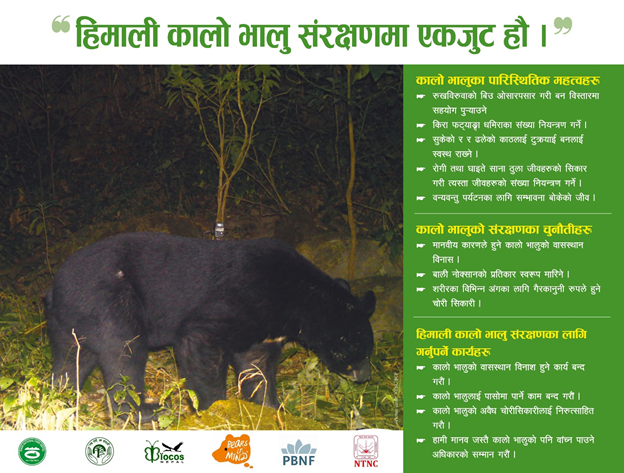
Three species of bears, the Asiatic black bear (Ursus thibetanus), the Tibetan brown bear (Ursus arctos pruinosus), and the Sloth bear (Melursus ursinus) are found in Nepal. Brown bears occur at the high mountain region, black bears in the middle mountains, and Sloth bears in the Terai and foothills of Churia in southern parts of Nepal. Although Nepal has achievements in wildlife conservation, bears are never listed as a conservation priority species. The Himalayan Black Bear is globally vulnerable and listed as a nationally endangered species in Nepal. Biodiversity Conservation Society Nepal (BIOCOSNEPAL) has been working towards the conservation of bears since 2019 initiating the conservation project from Annapurna Conservation Area (ACA). The project team from BIOCOSNEPAL found a presence in ACA up to 3,582m elevation and a population of 60 individuals in an area of 525 km2. Villagers reported maximum crop damage by bears, especially maize. In the diet analysis, 84% of fecal samples confined agriculture crops in the rainy season. The team also noticed poisoning, snaring, gunshots, and killing of bears because of crop damage. The project engaged existing local institutions for bear conservation by organizing substantial conservation education awareness programs, bear conservation workshops, and promotions of bear-based tourism in the conflict-prone sites of ACA.
Importantly, in recent years, western Nepal has faced an increasingly excessive human-wildlife conflict which resulted in the retaliatory killing of bears. Baseline information on conflict, status, and distribution of bears in general is lacking, for designing bear conservation and conflict mitigation measures. Therefore, with the support of Prince Bernhard Nature Fund and Bears in Mind, we initiated the research and conservation of Himalayan Black Bears in Nepal. Throughout the study, we will be assessing the extent and magnitude of Himalayan black bear (Ursus thibetanus laniger) – Human Conflict and importantly Habitat Occupancy in western, Nepal. The study will be conducted following an Occupancy Survey and Questionnaire Survey to assess the occupancy and habitat influencing variables as well as people’s perception and conflict zone.
#Figure:- Poster containing information about the Himalayan Black Bear and conservation Challenges.
The study will equally emphasize the conservation outreach program in coordination with local communities and schools, situated near bear habitats, to reduce Human – Bear Conflict, raising community awareness regarding the importance of bear safety measures, and awareness of the legal status regarding poaching and hunting of bears.
© 2019 Biodiversity Conservation Society Nepal. All Rights Reserved.
Website by Brevin Creation